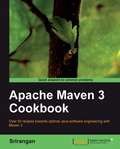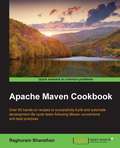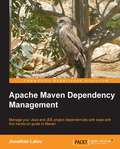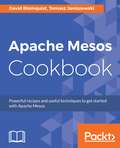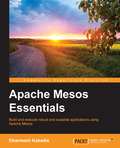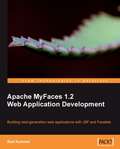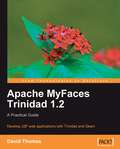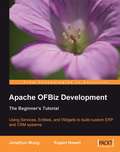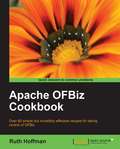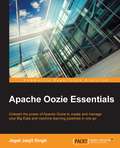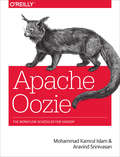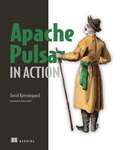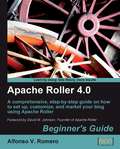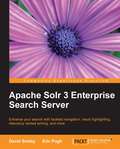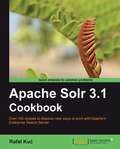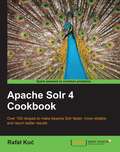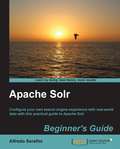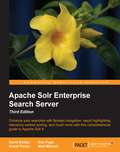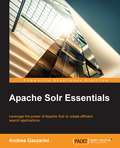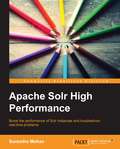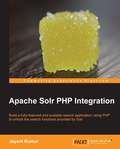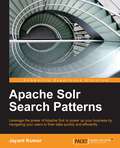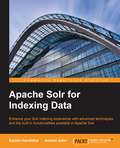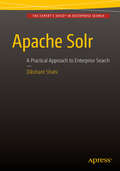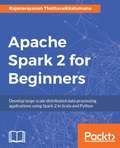- Table View
- List View
Apache Maven 3 Cookbook
by SriranganThis well-detailed Cookbook takes you step by step, doing one task at a time with the latest version of Apache Maven 3. You will find this Cookbook an answer to almost all your needs for building high-quality Java applications with well-explained code and many illustrations to quicken up your learning. If you're a Java developer, it will arm you with all the critical information you need to get to grips with Maven 3, the latest version of the powerful build tool by Apache. This book is for Java developers, teams, and managers who want to implement Apache Maven in their development process, leveraging the software engineering best practices and agile team collaboration techniques it brings along. The book is also specifically for the developer who wishes to get started in Apache Maven and use it with a range of emergent and enterprise technologies including Enterprise Java, Frameworks, Google App Engine, Android, and Scala.
Apache Maven Cookbook
by Raghuram BharathanIf you are a Java developer or a manager who has experience with Apache Maven and want to extend your knowledge, then this is the ideal book for you. Apache Maven Cookbook is for those who want to learn how Apache Maven can be used for build automation. It is also meant for those familiar with Apache Maven, but want to understand the finer nuances of Maven and solve specific problems.
Apache Maven Dependency Management
by Jonathan LalouAn easy-to-follow, tutorial-based guide with chapters progressing from basic to advanced dependency management.If you are working with Java or Java EE projects and you want to take advantage of Maven dependency management, then this book is ideal for you. This book is also particularly useful if you are a developer or an architect. You should be well versed with Maven and its basic functionalities if you wish to get the most out of this book.
Apache Mesos Cookbook
by David Blomquist Tomasz JaniszewskiOver 50 recipes on the core features of Apache Mesos and running big data frameworks in Mesos About This Book • Learn to install and configure Mesos to suit the needs of your organization • Follow step-by-step instructions to deploy application frameworks on top of Mesos, saving you many hours of research and trial and error • Use this practical guide packed with powerful recipes to implement Mesos and easily integrate it with other application frameworks Who This Book Is For This book is for system administrators, engineers, and big data programmers. Basic experience with big data technologies such as Hadoop or Spark would be useful but is not essential. A working knowledge of Apache Mesos is expected. What You Will Learn • Set up Mesos on different operating systems • Use the Marathon and Chronos frameworks to manage multiple applications • Work with Mesos and Docker • Integrate Mesos with Spark and other big data frameworks • Use networking features in Mesos for effective communication between containers • Configure Mesos for high availability using Zookeeper • Secure your Mesos clusters with SASL and Authorization ACLs • Solve everyday problems and discover the best practices In Detail Apache Mesos is open source cluster sharing and management software. Deploying and managing scalable applications in large-scale clustered environments can be difficult, but Apache Mesos makes it easier with efficient resource isolation and sharing across application frameworks. The goal of this book is to guide you through the practical implementation of the Mesos core along with a number of Mesos supported frameworks. You will begin by installing Mesos and then learn how to configure clusters and maintain them. You will also see how to deploy a cluster in a production environment with high availability using Zookeeper. Next, you will get to grips with using Mesos, Marathon, and Docker to build and deploy a PaaS. You will see how to schedule jobs with Chronos. We'll demonstrate how to integrate Mesos with big data frameworks such as Spark, Hadoop, and Storm. Practical solutions backed with clear examples will also show you how to deploy elastic big data jobs. You will find out how to deploy a scalable continuous integration and delivery system on Mesos with Jenkins. Finally, you will configure and deploy a highly scalable distributed search engine with ElasticSearch. Throughout the course of this book, you will get to know tips and tricks along with best practices to follow when working with Mesos. Style and approach This step-by-step guide is packed with powerful recipes on using Apache Mesos and shows its integration with containers and big data frameworks.
Apache Mesos Essentials
by Dharmesh KakadiaThis book is intended for developers and operators who want to build and run scalable and fault-tolerant applications leveraging Apache Mesos. A basic knowledge of programming with some fundamentals of Linux is a prerequisite.
Apache MyFaces 1.2 Web Application Development
by Bart KummelThe book is written as a step-by-step, example-driven tutorial designed to be worked through step by step working on the example code as you learn. A fun example scenario is used throughout the book and of course all source code is available to download from the author's web site. The book is packed with tips and tricks, based on experience with MyFaces in real-life projects. This book is intended for Java developers who want to develop web frontends for their enterprise applications using Apache MyFaces as JSF implementation. Some basic knowledge of JSF is expected.
Apache MyFaces Trinidad 1.2: A Practical Guide
by David ThomasThe book is a hands-on practical guide that stresses the discussion of code and builds up a sample application that illustrates all the standard UI types covered by Trinidad. This book is written for Java developers who are beginners at JSF and experienced web developers who are looking for an introduction into the world of open source JSF technology.
Apache OFBiz Development: The Beginner's Tutorial
by Jonathon Wong Rupert HowellThis is an accessible step-by-step tutorial that introduces readers to the world of OFBiz through practical examples and clear explanations. It will guide you through the framework, teach you to tweak OFBiz and master widgets, entities, and permissions, and give you the knowledge to customize your own bespoke applications. This book is for developers who want to build easily deployed and supported OFBiz applications. No previous knowledge of OFBiz is assumed, but readers should be comfortable in a Java development environment.
Apache OfBiz Cookbook
by Ruth HoffmanThe best way to experience OFBiz is to dive right in and start "kicking the tires". No matter if you are an end user exploring the out-of-the-box e-commerce web store or a software developer getting ready to build a new application, you will find, eventually, that you perform the same tasks over and over again. This book is designed as a reference to guide you though those oft-encountered OFBiz tasks. It is a collection of recipes, not necessarily in any particular order of importance, that address and give answers to many of the real-world questions asked about how to do things with OFBiz. If you are an OFBiz user who has some familiarity with enterprise software systems, and perhaps more importantly, Internet and Web exposure, you will be able to glean useful information from this book. You will need only basic knowledge of modern browser behavior (for example: how to click a mouse button) to follow some recipes, while others assume a passing familiarity with a text-editor and XML documents. If you are a software developer looking for Java and/or Groovy examples, this book also includes a chapter on Java software development.
Apache Oozie Essentials
by Jagat Jasjit SinghUnleash the power of Apache Oozie to create and manage your big data and machine learning pipelines in one go About This Book * Teaches you everything you need to know to get started with Apache Oozie from scratch and manage your data pipelines effortlessly * Learn to write data ingestion workflows with the help of real-life examples from the author's own personal experience * Embed Spark jobs to run your machine learning models on top of Hadoop Who This Book Is For If you are an expert Hadoop user who wants to use Apache Oozie to handle workflows efficiently, this book is for you. This book will be handy to anyone who is familiar with the basics of Hadoop and wants to automate data and machine learning pipelines. What You Will Learn * Install and configure Oozie from source code on your Hadoop cluster * Dive into the world of Oozie with Java MapReduce jobs * Schedule Hive ETL and data ingestion jobs * Import data from a database through Sqoop jobs in HDFS * Create and process data pipelines with Pig, hive scripts as per business requirements. * Run machine learning Spark jobs on Hadoop * Create quick Oozie jobs using Hue * Make the most of Oozie's security capabilities by configuring Oozie's security In Detail As more and more organizations are discovering the use of big data analytics, interest in platforms that provide storage, computation, and analytic capabilities is booming exponentially. This calls for data management. Hadoop caters to this need. Oozie fulfils this necessity for a scheduler for a Hadoop job by acting as a cron to better analyze data. Apache Oozie Essentials starts off with the basics right from installing and configuring Oozie from source code on your Hadoop cluster to managing your complex clusters. You will learn how to create data ingestion and machine learning workflows. This book is sprinkled with the examples and exercises to help you take your big data learning to the next level. You will discover how to write workflows to run your MapReduce, Pig ,Hive, and Sqoop scripts and schedule them to run at a specific time or for a specific business requirement using a coordinator. This book has engaging real-life exercises and examples to get you in the thick of things. Lastly, you'll get a grip of how to embed Spark jobs, which can be used to run your machine learning models on Hadoop. By the end of the book, you will have a good knowledge of Apache Oozie. You will be capable of using Oozie to handle large Hadoop workflows and even improve the availability of your Hadoop environment. Style and approach This book is a hands-on guide that explains Oozie using real-world examples. Each chapter is blended beautifully with fundamental concepts sprinkled in-between case study solution algorithms and topped off with self-learning exercises.
Apache Oozie: The Workflow Scheduler for Hadoop
by Aravind Srinivasan Mohammad Kamrul IslamGet a solid grounding in Apache Oozie, the workflow scheduler system for managing Hadoop jobs. With this hands-on guide, two experienced Hadoop practitioners walk you through the intricacies of this powerful and flexible platform, with numerous examples and real-world use cases.Once you set up your Oozie server, you’ll dive into techniques for writing and coordinating workflows, and learn how to write complex data pipelines. Advanced topics show you how to handle shared libraries in Oozie, as well as how to implement and manage Oozie’s security capabilities.Install and configure an Oozie server, and get an overview of basic conceptsJourney through the world of writing and configuring workflowsLearn how the Oozie coordinator schedules and executes workflows based on triggersUnderstand how Oozie manages data dependenciesUse Oozie bundles to package several coordinator apps into a data pipelineLearn about security features and shared library managementImplement custom extensions and write your own EL functions and actionsDebug workflows and manage Oozie’s operational details
Apache Pulsar in Action
by David KjerrumgaardDeliver lightning fast and reliable messaging for your distributed applications with the flexible and resilient Apache Pulsar platform.In Apache Pulsar in Action you will learn how to: Publish from Apache Pulsar into third-party data repositories and platforms Design and develop Apache Pulsar functions Perform interactive SQL queries against data stored in Apache Pulsar Apache Pulsar in Action is a comprehensive and practical guide to building high-traffic applications with Pulsar. You&’ll learn to use this mature and battle-tested platform to deliver extreme levels of speed and durability to your messaging. Apache Pulsar committer David Kjerrumgaard teaches you to apply Pulsar&’s seamless scalability through hands-on case studies, including IOT analytics applications and a microservices app based on Pulsar functions. Purchase of the print book includes a free eBook in PDF, Kindle, and ePub formats from Manning Publications. About the technology Reliable server-to-server messaging is the heart of a distributed application. Apache Pulsar is a flexible real-time messaging platform built to run on Kubernetes and deliver the scalability and resilience required for cloud-based systems. Pulsar supports both streaming and message queuing, and unlike other solutions, it can communicate over multiple protocols including MQTT, AMQP, and Kafka&’s binary protocol. About the book Apache Pulsar in Action teaches you to build scalable streaming messaging systems using Pulsar. You&’ll start with a rapid introduction to enterprise messaging and discover the unique benefits of Pulsar. Following crystal-clear explanations and engaging examples, you&’ll use the Pulsar Functions framework to develop a microservices-based application. Real-world case studies illustrate how to implement the most important messaging design patterns. What's inside Publish from Pulsar into third-party data repositories and platforms Design and develop Apache Pulsar functions Create an event-driven food delivery application About the reader Written for experienced Java developers. No prior knowledge of Pulsar required. About the author David Kjerrumgaard is a committer on the Apache Pulsar project. He currently serves as a Developer Advocate for StreamNative, where he develops Pulsar best practices and solutions. Table of Contents PART 1 GETTING STARTED WITH APACHE PULSAR 1 Introduction to Apache Pulsar 2 Pulsar concepts and architecture 3 Interacting with Pulsar PART 2 APACHE PULSAR DEVELOPMENT ESSENTIALS 4 Pulsar functions 5 Pulsar IO connectors 6 Pulsar security 7 Schema registry PART 3 HANDS-ON APPLICATION DEVELOPMENT WITH APACHE PULSAR 8 Pulsar Functions patterns 9 Resiliency patterns 10 Data access 11 Machine learning in Pulsar 12 Edge analytics
Apache Roller 4.0 – Beginner's Guide
by Alfonso RomeroThis beginner's guide is packed with information, tips, and tricks, based on the author's extensive experience with Apache Roller. In next to no time, you will be able to build and deploy your own blog. The clear and concise hands-on exercises will teach you everything you need to know to install, configure, and use Apache Roller, along with the open source software required to run it. The book includes plenty of illustrations to guide you through all the detailed exercises and tutorials, so you can get the most out of every chapter. If you are interested in establishing a blog, using Apache Roller and popular web applications to write attractive posts and promote your blog on all the major social bookmarking services, this book is for you. No previous experience on Tomcat, MySQL, the Apache Web Server, or Linux is required.
Apache Solr 3 Enterprise Search Server
by David Smiley Eric PughThe book is written as a reference guide. It includes fully working examples based on a real-world public data set.This book is for developers who want to learn how to use Apache Solr in their applications. Only basic programming skills are needed.
Apache Solr 3.1 Cookbook
by Rafa KuThis book is part of Packt's Cookbook series; each chapter looks at a different aspect of working with Apache Solr. The recipes deal with common problems of working with Solr by using easy-to-understand, real-life examples. The book is not in any way a complete Apache Solr reference and you should see it as a helping hand when things get rough on your journey with Apache Solr.Developers who are working with Apache Solr and would like to know how to combat common problems will find this book of great use. Knowledge of Apache Lucene would be a bonus but is not required.
Apache Solr 4 Cookbook
by Rafal KucApache Solr 4 Cookbook is written in a helpful, practical style with numerous hands-on recipes to help you master Apache Solr to get more precise search results and analysis, higher performance, and reliability. This book is for developers who wish to learn how to master Apache Solr 4. This book will specifically appeal to developers who wish to quickly get to grips with the changes and new features of Apache Solr 4. This book is also handy as a practical guide to solving common problems and issues when using Apache Solr.
Apache Solr Beginner's Guide
by Alfredo SerafiniWritten in a friendly, example-driven format, the book includes plenty of step-by-step instructions and examples that are designed to help you get started with Apache Solr.This book is an entry level text into the wonderful world of Apache Solr. The book will center around a couple of simple projects such as setting up Solr and all the stuff that comes with customizing the Solr schema and configuration. This book is for developers looking to start using Apache Solr who are stuck or intimidated by the difficulty of setting it up and using it.For anyone wanting to embed a search engine in their site to help users navigate around the mammoth data available this book is an ideal starting point. Moreover, if you are a data architect or a project manager and want to make some key design decisions, you will find that every example included in the book contains ideas usable in real-world contexts.
Apache Solr Enterprise Search Server - Third Edition
by David SmileyThis book is for developers who want to learn how to get the most out of Solr in their applications, whether you are new to the field, have used Solr but don't know everything, or simply want a good reference. It would be helpful to have some familiarity with basic programming concepts, but no prior experience is required.
Apache Solr Essentials
by Andrea GazzariniIf you are a competent developer with experience of working with technologies similar to Apache Solr and want to develop efficient search applications, then this book is for you. Familiarity with the Java programming language is required.
Apache Solr High Performance
by Surendra MohanThis book is an easy-to-follow guide, full of hands-on, real-world examples. Each topic is explained and demonstrated in a specific and user-friendly flow, from search optimization using Solr to Deployment of Zookeeper applications. This book is ideal for Apache Solr developers and want to learn different techniques to optimize Solr performance with utmost efficiency, along with effectively troubleshooting the problems that usually occur while trying to boost performance. Familiarity with search servers and database querying is expected.
Apache Solr PHP Integration
by Jayant KumarThis book is full of step-by-step example-oriented tutorials which will show readers how to integrate Solr in PHP applications using the available libraries, and boost the inherent search facilities that Solr offers.If you are a developer who knows PHP and is interested in integrating search into your applications, this is the book for you. No advanced knowledge of Solr is required. Very basic knowledge of system commands and the command-line interface on both Linux and Windows is required. You should also be familiar with the concept of Web servers.
Apache Solr Search Patterns
by Jayant KumarThis book is for developers who already know how to use Solr and are looking at procuring advanced strategies for improving their search using Solr. This book is also for people who work with analytics to generate graphs and reports using Solr. Moreover, if you are a search architect who is looking forward to scale your search using Solr, this is a must have book for you. It would be helpful if you are familiar with the Java programming language.
Apache Solr for Indexing Data
by Anshul Johri Sachin HandiekarEnhance your Solr indexing experience with advanced techniques and the built-in functionalities available in Apache Solr About This Book * Learn about distributed indexing and real-time optimization to change index data on fly * Index data from various sources and web crawlers using built-in analyzers and tokenizers * This step-by-step guide is packed with real-life examples on indexing data Who This Book Is For This book is for developers who want to increase their experience of indexing in Solr by learning about the various index handlers, analyzers, and methods available in Solr. Beginner level Solr development skills are expected. What You Will Learn * Get to know the basic features of Solr indexing and the analyzers/tokenizers available * Index XML/JSON data in Solr using the HTTP Post tool and CURL command * Work with Data Import Handler to index data from a database * Use Apache Tika with Solr to index word documents, PDFs, and much more * Utilize Apache Nutch and Solr integration to index crawled data from web pages * Update indexes in real-time data feeds * Discover techniques to index multi-language and distributed data in Solr * Combine the various indexing techniques into a real-life working example of an online shopping web application In Detail Apache Solr is a widely used, open source enterprise search server that delivers powerful indexing and searching features. These features help fetch relevant information from various sources and documentation. Solr also combines with other open source tools such as Apache Tika and Apache Nutch to provide more powerful features. This fast-paced guide starts by helping you set up Solr and get acquainted with its basic building blocks, to give you a better understanding of Solr indexing. You'll quickly move on to indexing text and boosting the indexing time. Next, you'll focus on basic indexing techniques, various index handlers designed to modify documents, and indexing a structured data source through Data Import Handler. Moving on, you will learn techniques to perform real-time indexing and atomic updates, as well as more advanced indexing techniques such as de-duplication. Later on, we'll help you set up a cluster of Solr servers that combine fault tolerance and high availability. You will also gain insights into working scenarios of different aspects of Solr and how to use Solr with e-commerce data. By the end of the book, you will be competent and confident working with indexing and will have a good knowledge base to efficiently program elements. Style and approach This fast-paced guide is packed with examples that are written in an easy-to-follow style, and are accompanied by detailed explanation. Working examples are included to help you get better results for your applications.
Apache Solr: A Practical Approach to Enterprise Search
by Dikshant ShahiBuild an enterprise search engine using Apache Solr: index and search documents; ingest data from varied sources; apply various text processing techniques; utilize different search capabilities; and customize Solr to retrieve the desired results. Apache Solr: A Practical Approach to Enterprise Search explains each essential concept--backed by practical and industry examples--to help you attain expert-level knowledge. The book, which assumes a basic knowledge of Java, starts with an introduction to Solr, followed by steps to setting it up, indexing your first set of documents, and searching them. It then introduces you to information retrieval and its implementation in Apache Solr; this will help you understand your search problem, decide the approach to build an effective solution, and use various metrics to evaluate the results. The book next covers the schema design and techniques to build a text analysis chain for cleansing, normalizing and enriching your documents and addressing different types of search queries. It describes various popular matching techniques which are generally applied to improve the precision and recall of searches. You will learn the end-to-end process of data ingestion from varied sources, metadata extraction, pre-processing and transformation of content, various search components, query parsers and other advanced search capabilities. After covering out-of-the-box features, Solr expert Dikshant Shahi dives into ways you can customize Solr for your business and its specific requirements, along with ways to plug in your own components. Most important, you will learn about implementations for Solr scoring, factors affecting the document score, and tuning the score for the application at hand. The book explains why textual scoring is not sufficient for practical ranking of documents and ways to integrate real-world factors for contributing to the document ranking. You'll see how to influence user experience by providing suggestions and recommendations. You'll also see integration of Solr with important related technologies such as OpenNLP and Tika. Additionally, you will learn about scaling Solr using SolrCloud. This book concludes with coverage of semantic search capabilities, which is crucial for taking the search experience to the next level. By the end of Apache Solr, you will be proficient in designing and developing your search engine. What you'll learn How to develop a search engine using Solr How to implement information retrieval concepts How to master search engine internals How to build your search strategy Hot to customize Solr for your unique search problem How to make your search engine intelligent and self-learning Who this book is for Professionals into data mining, data management, or Web development. Table of Contents Chapter 1: Introduction to Search Engines and Solr Chapter 2: Solr Setup and Administration Chapter 3: Understanding Information Retrieval Chapter 4: Search Strategy and Schema Design Chapter 5: Indexing Data Chapter 6: Searching Solr Chapter 7: Advanced Querying Chapter 8: Customizing Document Ranking Chapter 9: Going Beyond Text Matching Chapter 10: SolrCloud Chapter 11: Practical Search Examples
Apache Spark 2 for Beginners
by Rajanarayanan ThottuvaikkatumanaDevelop large-scale distributed data processing applications using Spark 2 in Scala and Python About This Book * This book offers an easy introduction to the Spark framework published on the latest version of Apache Spark 2 * Perform efficient data processing, machine learning and graph processing using various Spark components * A practical guide aimed at beginners to get them up and running with Spark Who This Book Is For If you are an application developer, data scientist, or big data solutions architect who is interested in combining the data processing power of Spark from R, and consolidating data processing, stream processing, machine learning, and graph processing into one unified and highly interoperable framework with a uniform API using Scala or Python, this book is for you. What You Will Learn * Get to know the fundamentals of Spark 2 and the Spark programming model using Scala and Python * Know how to use Spark SQL and DataFrames using Scala and Python * Get an introduction to Spark programming using R * Perform Spark data processing, charting, and plotting using Python * Get acquainted with Spark stream processing using Scala and Python * Be introduced to machine learning using Spark MLlib * Get started with graph processing using the Spark GraphX * Bring together all that you've learned and develop a complete Spark application In Detail Spark is one of the most widely-used large-scale data processing engines and runs extremely fast. It is a framework that has tools that are equally useful for application developers as well as data scientists. This book starts with the fundamentals of Spark 2 and covers the core data processing framework and API, installation, and application development setup. Then the Spark programming model is introduced through real-world examples followed by Spark SQL programming with DataFrames. An introduction to SparkR is covered next. Later, we cover the charting and plotting features of Python in conjunction with Spark data processing. After that, we take a look at Spark's stream processing, machine learning, and graph processing libraries. The last chapter combines all the skills you learned from the preceding chapters to develop a real-world Spark application. By the end of this book, you will have all the knowledge you need to develop efficient large-scale applications using Apache Spark. Style and approach Learn about Spark's infrastructure with this practical tutorial. With the help of real-world use cases on the main features of Spark we offer an easy introduction to the framework.
